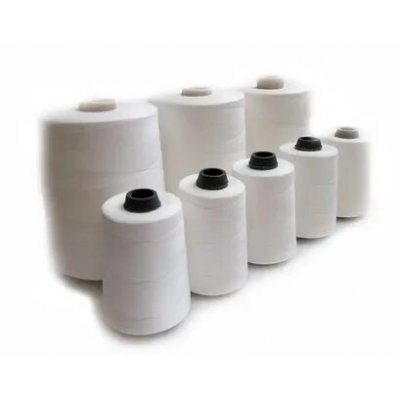Cotton yarn
Cotton yarn is processed by the carded spinning system into medium-staple cotton with a length of 24-35 mm. Carded yarn has an average linear density (12-125 tex). This is the most common type of cotton yarn. carded yarn differs from combed yarn in increased thickness and some fluffiness; it is used to produce a wide range of fabrics: calico, calico, etc.
The combed system processes the thinnest and longest fibers (fine-staple cotton).
To obtain combed yarn from long-staple cotton, additional carding is carried out on combers with special combs.
Short fibers are not held in the clamps and are combed out. A ribbon is formed, consisting of only long, well-straightened and parallel fibers.
Combed yarn is characterized by the lowest linear density (6-16 tex), increased strength, uniformity in twist and linear density. The fabrics obtained from it have a low surface density, small thickness, increased strength, gloss and a smooth surface. yarn is used to make fabrics such as cambric, voile, chiffon, etc., as well as to produce sewing threads.
The apparatus spinning system is used to process a mass of heterogeneous and relatively short fibers: low-grade cotton, carded and combed cotton waste.
To obtain hardware yarn, the operations of adding and pulling tapes and pre-spinning are excluded. Therefore, hardware yarn has a large linear density (60-1000 tex), is uneven in thickness, loose, fluffy, soft. This type of yarn is used to produce winter range fabrics, such as fumes, flannel, baize, etc. They are characterized by increased heat-shielding properties.
Characteristic
(for raw cotton yarn, single yarn, twisted yarn, knitted yarn)
| Type of cotton yarn |
| Rated Nm 20/1 |
| Yarn thickness tex 50/1 |
| Type of packaging Reels in bags |
| combed, carded process |
| From cotton I III gr. IV-V gr. OE
|
|
| The name of indicators | Indicator |
| 1 | Standard yarn thickness tex | 50/1 |
| 2 | Relative deviation of standard thickness tex | 0.9 |
| 3 | Relative breaking load of a single thread >#/span### | 12.6 |
| 4 | The coefficient of variation for the breaking load of a single thread in percent. | 7 |
| 5 | Coefficient of variation in thickness percent | 4.2 |
| 6 | Level of quality | 1.2 |
| 7 | Yarn grade | First |
| 8 | Yarn class | BUT |
| 9 | Twist factor | 41.0 |
| 10 | Actual humidity in percent | 7.0 |
Characteristic
(for raw cotton yarn, single yarn, twisted yarn, knitted yarn)
| Type of cotton yarn |
| Rated Nm 34/1 |
| Yarn thickness tex 29.0 |
| Type of packaging Reels in bags |
| combed, carded process |
| From cotton I III gr. IV-V gr. OE
|
|
| The name of indicators | Indicator |
| One11 1 | Standard yarn thickness tex | 29.0 |
| 2 | Relative deviation of standard thickness tex | 1.1 |
| 3 | Relative breaking load of a single thread >#/span### | 12 |
| 4 | The coefficient of variation for the breaking load of a single thread in percent. | 7.8 |
| 5 | Coefficient of variation in thickness percent | 3.9 |
| 6 | Level of quality | 1.12 |
| 7 | Yarn grade | First |
| 8 | Yarn class | BUT |
| 9 | Twist factor | 41.0 |
| 10 | Actual humidity in percent | 7.0 |
No reviews found

























































